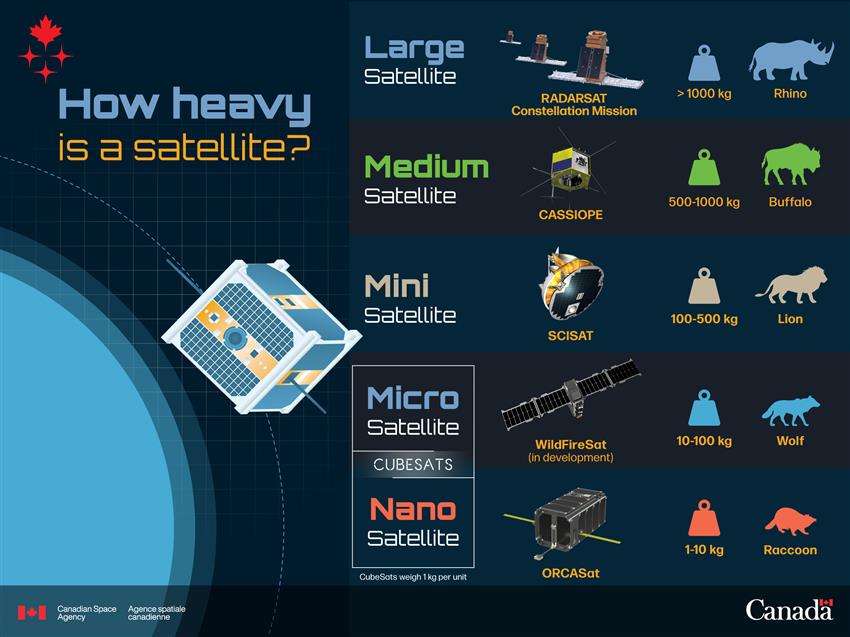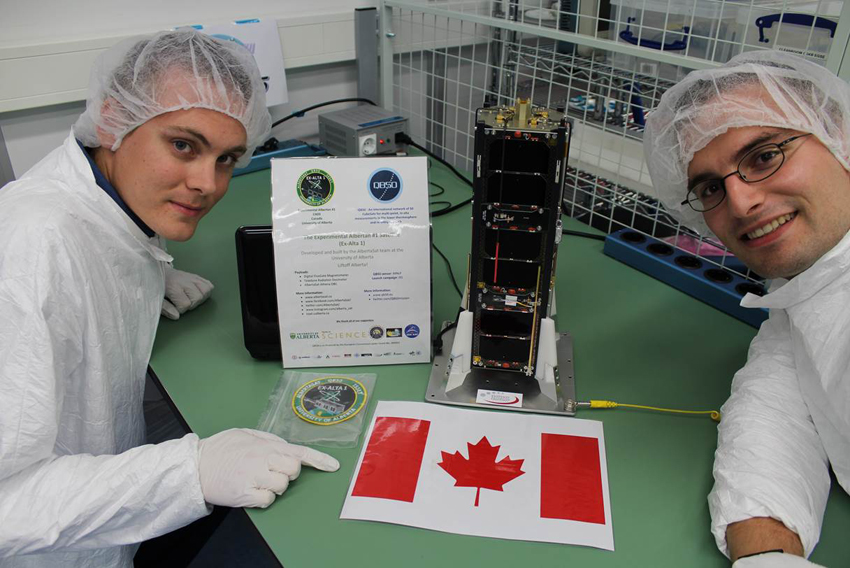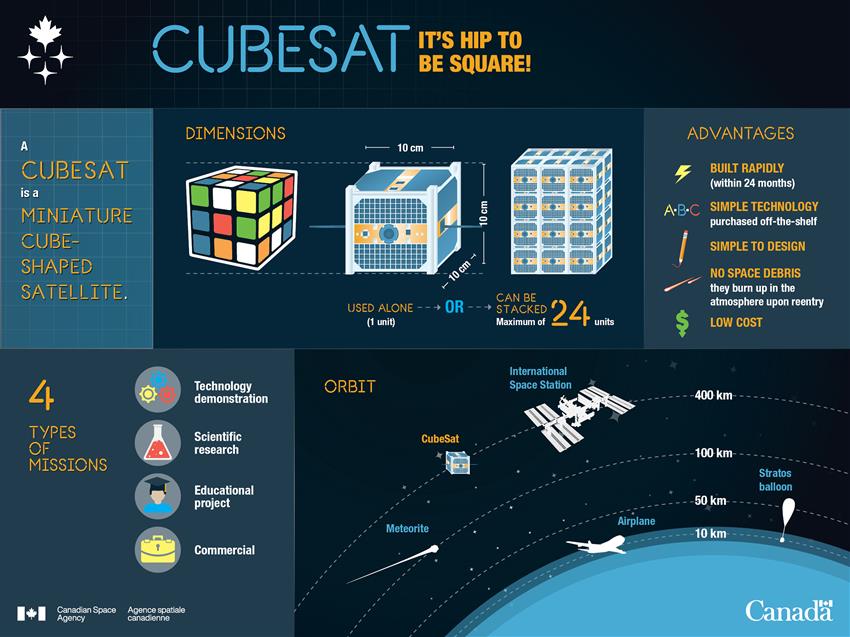CubeSats in a nutshell
On this page
CubeSats in a nutshell
A CubeSat is a square-shaped miniature satellite (10 cm × 10 cm × 10 cm—roughly the size of a Rubik's cube), weighing about 1 kg. A CubeSat can be used alone (1 unit) or in groups of multiple units (maximum 24 units).
CubeSats can be used to test instruments, conduct science experiments, enable commercial applications and support educational projects. (Credits: Canadian Space Agency [CSA], NASA, University of Alberta)
Using CubeSats
| Type of mission | Description | Example | |
|---|---|---|---|
 |
Technology demonstration |
The harsh environment of space is the ultimate test bed. CubeSats can help test new instruments or materials and validate their readiness to be integrated into a more complex space mission. |
A CubeSat could be used to study the performance of a new thermal imaging camera by using it with different settings to evaluate the quality of images captured and the overall reliability of the instrument. |
 |
Science |
CubeSats can carry small science instruments to conduct an experiment or take measurements from space. |
It could collect information on the magnetic field to better understand and predict its fluctuations in order to improve earthquake detection. |
 |
Educational projects |
CubeSats can provide students with a unique hands-on experience in developing space missions from design, to launch and operations. |
A CubeSat could be used by students to track the movement of wild animals, like herds of reindeer or polar bears, by collecting radio signals emitted from collars attached to the animals. |
 |
Commercial |
CubeSats can be used for commercial applications, like providing telecommunications services or capturing Earth observation images. |
A company owning a CubeSat equipped with a camera could sell high-resolution images of the Earth to clients in agriculture, city planning or business intelligence. |
Things CubeSats have in common
Just like any satellite, CubeSats are custom built to the specific requirements of their mission and have at least three things in common:
- The antenna and radio communication system, which sends and receives information to and from Earth.
- The power source, like a solar panel or simply a battery.
- The computer, which executes instructions to ensure proper functioning of the satellite.
The main cubic structure is made of aluminum and serves to hold the above components along with others such as cameras, sensors or scientific payloads. In addition, antennas and solar panels can be installed on the exterior of the structure.
Did you know?
- 1999 – The first CubeSat concept is developed by professors from California Polytechnic State University and Stanford University to provide students with an affordable, hands-on experience in space exploration.
- 2003 – First CubeSat launch.
- To date, more than 510 CubeSats have been launched into space by 50 countries.
Launching CubeSats in space
To be launched into space, CubeSats hitch a ride into space using extra space available on rockets. They are packed in a container which, with the push of a button, activates a spring that ejects the CubeSats into space. CubeSats can also be deployed from the International Space Station (ISS) by using the same technique from the airlock in the Japanese module. Like other satellites, they can be flown alone or in a constellation network, in orbit around the Earth.
This video shows the successful deployment of Ex-Alta 1, University of Alberta's CubeSat, from the ISS. (Credits: CSA, NASA)
Why size matters
Artificial satellites come in a variety of sizes ranging from one you can hold in your hand to the size of a school bus: small satellites, nano satellites, miniature satellites, traditional satellites. Their dimension and costs are mostly determined by the complexity and type of their instruments (commonly known as payloads). In recent years, thanks to the miniaturization of space technologies, satellites have become smaller for a number of reasons, the first being the cost associated with assembly and launch.

The dimensions of a CubeSat - Text version
The dimensions of a CubeSat are illustrated. It is 10 centimetres on each side, making it similar in size to a Rubik's cube. A graphic shows that a CubeSat can be used alone, or a maximum of 24 CubeSats can be stacked.
CubeSats can be used alone or stacked to suit the needs of a specific mission. (Credit: CSA)

How heavy is a satellite? - Illustration - Text version
Chart of the approximate weight of satellites launched into space, according to their category. (Credit: CSA)
The benefits of using CubeSats
Pros
- Fast: can be built within two years
- Cost: far less expensive than large satellites
- Technology: simple, standard parts available off-the-shelf
- Design: simple design for short mission; no need to use thermal blankets
- Space debris: none – they burn up in the atmosphere upon re-entry
Cons
- Scope: limited due to reduced capacity to carry scientific instruments
- Mission duration: most of them are operational for a period of 3 to 12 months
Who uses CubeSats?
CubeSat rapidly expanded beyond educational purposes and created its own niche with government, industry and academia, who are collaborating to increase its technological capabilities.
Schools
CubeSats do the following:
- Give students experience in developing flight hardware and conducting space missions.
- Assist professors and faculties in preparing Canada's next-generation skilled workforce.

Collin Cupido and Charles Nokes are part of the team of students from the University of Alberta that received funding from the Canadian Space Agency to build the Ex-Alta 1 CubeSat and participate in the international QB50 mission. (Credit: Collin Cupido, University of Alberta)
Government and industry
CubeSats are a game changer; labelled as faster, smaller, smarter and cheaper, they are valuable to government and industry for:
- Providing a platform for low-cost technology development and scientific research
- Enabling the acceleration of flight-qualified technology
- Generating innovative public-private partnerships
- Offering opportunities to develop the expertise and skills required for careers in the space sector
Looking to the future
CubeSats are revolutionizing access to space: developers and users are eagerly taking advantage of this new platform to increase research and development activities conducted in space.
CubeSats are even being used for interplanetary missions: NASA's Mars Cube One (MarCO) will embark on a mission to Mars in . CubeSats will offer an experimental communications service relaying information to Earth during atmospheric entry and landing.

Illustration depicting the future MarCO mission, during which two CubeSats will fly by Mars while the InSight lander is touching down on the red planet. (Credit: NASA)

CubeSat – It's hip to be square! - Illustration - Text version
CubeSat at a glance. (Credit: CSA)
